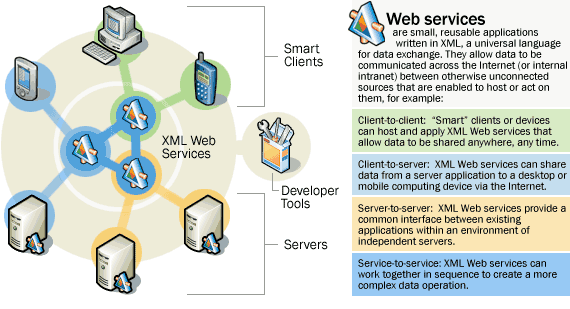The Basic Elements of Microsoft.NET
Looking to put your software solution on the right track? Get caught in .NET!
Microsoft® .NET is a set of Microsoft software technologies for connecting information, people, systems, and devices. It enables a high level of software integration through the use of Web services—small, discrete, building-block applications that connect to each other as well as to other, larger applications over the Internet.
|
 |
  |
 |
| The Components of Microsoft .NET-Connected Software |
| .NET is infused into the products that make up the Microsoft platform, providing the ability to quickly and reliably build, host, deploy, and utilize connected solutions using Web services, all with the protection of industry-standard security technologies. |
 |
 |
 |
 |
"Smart" client application software and operating systems enable PCs and other smart computing devices to act on Web services, allowing anywhere, anytime access to information. |
 |
 |
Microsoft and others are developing a core set Web services—from authentication to calendaring—that can be combined with other Web services or used directly with smart client applications. The Microsoft MapPoint® Web Service allows you to integrate high-quality maps, driving directions, and other location intelligence into your applications, business processes, and websites is an example of one of these services. |
 |
 |
Microsoft provides the best server infrastructure—the Microsoft Windows Server System™—for deploying, managing, and orchestrating Web services. |
 |
 |
Microsoft Visual Studio® .NET and the Microsoft .NET Framework are a complete solution for developers to build, deploy, and run Web services. |
 |
| More Details about the Microsoft .NET Framework |
| The Microsoft® .NET Framework is an important new component of the Microsoft Windows® family of operating systems. It is the foundation of the next generation of Windows-based applications that are easier to build, deploy, and integrate with other networked systems. |
 |
| Most consumers will never notice that the .NET Framework is running on their Pocket PC, smartphone, or desktop computer. But they may appreciate the reliability, ease of use, and ability to connect to other systems that the .NET Framework helps bring to computers. |
 |
| The .NET Framework helps software developers and systems administrators more easily build and maintain systems with improvements toward performance, security, and reliability. Here's how. |
 |
| A New Approach to Building Windows Software |
| The .NET Framework simplifies Windows software development. It provides developers with a single approach to build both desktop applications—sometimes called smart client applications—and Web-based applications. It also enables developers to use the same tools and skills to develop software for a variety of systems ranging from handheld smartphones to large server installations. |
 |
| Software built on the .NET Framework can be easier to deploy and maintain than conventional software. Applications can be designed to automatically upgrade themselves to the latest version. The .NET Framework can also minimize conflicts between applications by helping incompatible software components coexist. |
 |
| Benefits of the .NET Framework |
| The key advantages of the .NET Framework include that it: |
 |
-
Helps IT professionals better integrate existing systems with its native support for Web services.
-
Assists with the deployment of software to both users and Web servers.
-
Facilitates the development of software with improved reliability, scalability, performance, and security.
-
Helps developers be more productive by:
-
Making it easier for them to reuse existing code.
-
Enabling them to more easily integrate components written in any of the more than 20 supported programming languages.
-
Helping them more easily build software for a wide range of devices using same skills and tools.
|
 |
| Basic Components of the .NET Framework |
| The .NET Framework consists of two main parts: the common language runtime and the .NET Framework class library. |
 |
-
Common language runtime. Provides the common services for .NET Framework applications. Programs can be written for the common language runtime in just about every language, including C, C++, C#, and Microsoft Visual Basic®, as well as some older languages such as Fortran. The runtime simplifies programming by assisting with many mundane tasks of writing code. These tasks include memory management—which can be a big generator of bugs—security management, and error handling.
-
.NET Framework class library. The library includes prepackaged sets of functionality that developers can use to more rapidly extend the capabilities of their own software. The library includes three key components:
-
ASP.NET to help build Web applications and Web services.
-
Windows Forms to facilitate smart client user interface development.
-
ADO.NET to help connect applications to databases.
|